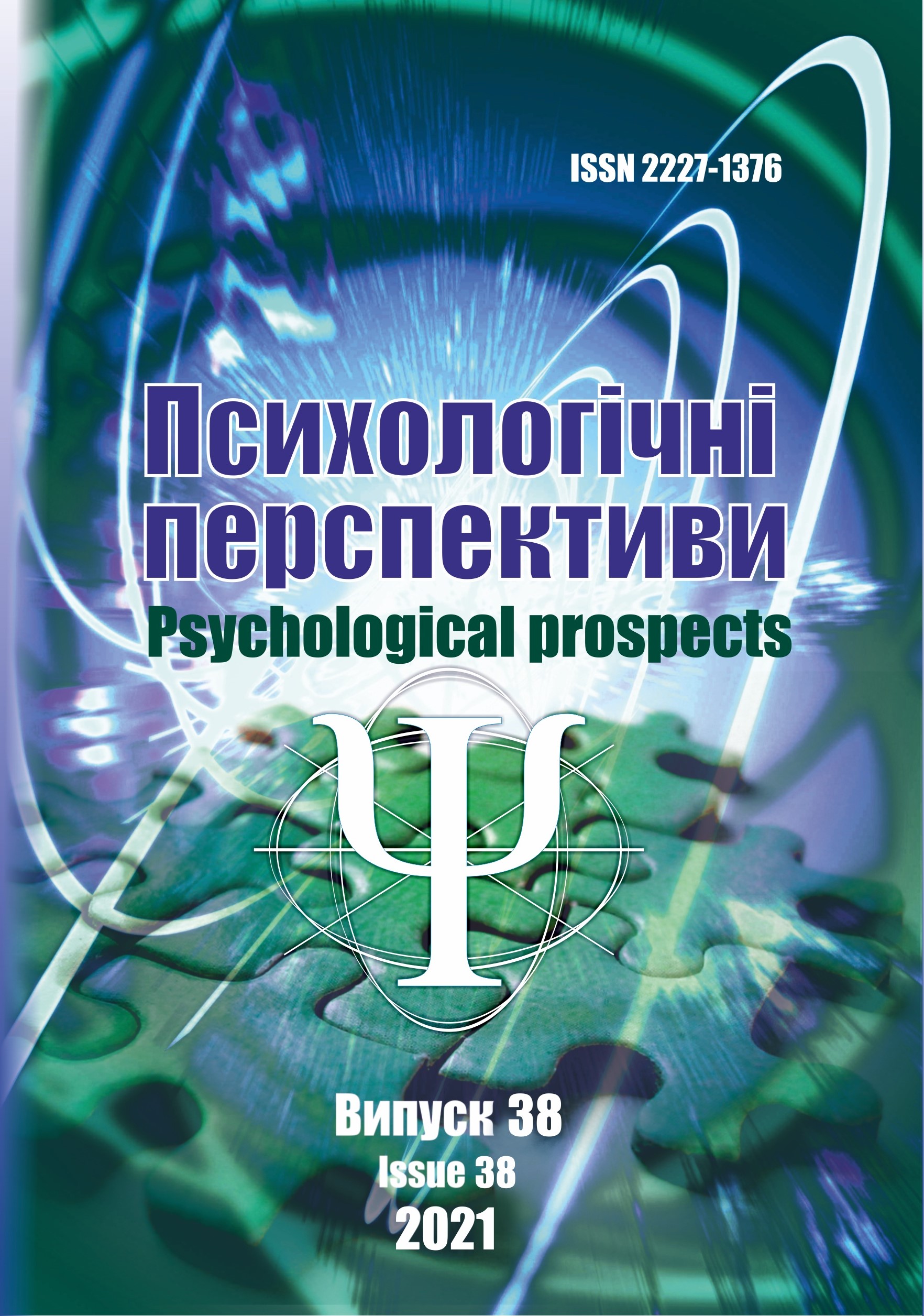Distrust as a psychological phenomenon
DOI:
https://doi.org/10.29038/2227-1376-2021-38-124-137Keywords:
Trust, distrust, credulity, safety, danger.Abstract
Purpose. The article provides a theoretical analysis of the problem of mistrust as a psychological phenomenon that is closely related to trust.
Methods. To achieve the purpose of the study, methods of psychosocial approach are used (because mistrust is manifested both internally and externally); subjective approach (because mistrust is an independent psychological phenomenon); system approach (allows to take into account all connections, types, forms, criteria of trust-distrust, as well as determinants, consequences, functions). With the help of these methods the essence of distrust is revealed, which has its own criteria and features.
Results. Analysis of domestic and foreign works on the psychological phenomenon of mistrust allows us to consider it as a means of ensuring human existence in the global world. Along with other sciences (philosophy, sociology, culturology, economics), which study trust – distrust, psychology has a number of methodological and technological problems. The connection between self-confidence and trust in the world is investigated. The task of the study is to determine the essence of distrust; to trace the connection between trust in oneself and trust in the world; to expand the notion of distrust as a means of personal security; to study distrust as a personality trait. An important point in the existence of a balance of self-confidence and trust in others is the level of self-reflection (awareness, spirituality), which will provide a person with peace and acceptance in an unknown difficult situation or fear and rejection, which often drives a person to act non-stereotypically or stereotypically.
Conclusions. In general, it can be concluded that mistrust can manifest itself in suspicion, jealousy, inner tension, "protection", naivety, conformity, dogmatism, negativism, skepticism, intimophobia, unwillingness to make long-term plans, fear of change, excessive propensity to engage. The existence of a balance of self-confidence and trust in others is the level of self-reflection (awareness, spirituality), which will provide a person with balance and self-efficacy in solving life's problems.
References
Antonenko, I.V. (2004). Doverie: sotsialno-psihologicheskiy fenomen [Trust: a socially psychological phenomenon]. М. [in Russian].
Baraniuk, N. I. (2019). Teoretychni aspekty rozuminnia psykholohii bezpeky [Theoretical aspects of understanding psychological safety]. Psykholohiia natsionalnoi bezpeky i blahopoluchchia osobystosti : tezy I Mizhnarodnoi naukovo-praktychnoi konferentsii - Proceedings of the Ist International Research-to-Practice Conference, Psykhologiia natsionalnoi bezpeky i blagopoluchchia osobystosti, 14-15 March 2019. Lviv: Lviv Politeknika [in Ukrainian].
Blatt, S. (1982). Dependency and self-criticism: psychological dimensions of depression. Journal of Consulting and Clinical Psychology,50, 113–124.
Ekman, P. (2009). Psihologiya lzhi [Psychology of lies]. SPb.: Piter [in Russian].
Ilin, Ye.P. (2013). Psihologiya doveriya [Psychology of trust]. SPb.: Piter [in Russian].
Giddens, A. (1991). Modernity and Self-Identity. Self and Society in the Late Modern Age. Cambridge: Polity Press.
Jaromowic, M., Szuster, A. (2016). Self-We-Others Schemata Differentiation as a Base for Personal Agency and Social Attitudes. Frontiers in psychology, 7. DOI: https://doi.org/10.3389/fpsyg.2016.01227
Karpiuk Yu. Ya. (2012). Vplyv khrystyianskoi morali na tsinnisno-oriientatsiinu sferu molodshykh shkoliariv [Influence of Christian ethics on value-oriented sphere of younger school children]. Extended abstract of candidate’s thesis. Ivano-Frankivsk: State Higher Educational Establishment “Vasyl Stefanyk Precarpathian National University” [in Ukrainian].
Kravchenko V.Yu. (2019). Dovira yak chastyna struktury stiikosti osobystosti [Trust as part of the structure of personality’s resilience]. Development of modern science: the Experience of European Countries and Prospects for Ukraine (P. 240 – 273). Riga: Publishing House “Baltija Publishing” [in Ukrainian].
Kupreichenko A.B. (2008). Psihologiya doveriya i nedoveriya [Psychology of trust and distrust]. М.: «Institute of Psychology of RAS» [in Russian].
Kupreichenko A.B., Tabkharova S.P. (2007). Kriterii doveriya i nedoveriya lichnosti drugim lyudyam [Criteria of trust and distrust of other people]. Psihologicheskiy zhurnal - Psychological Journal, 2, 55-67 [in Russian].
Keyes, C. L. M., Shmotkin, D., Ryff, C. D. (2002). Optimizing well-being: The empirical encounter of two traditions. Journal of Personality and Social Psychology, 82, 1007–1022.
Oldhem,J.M., Morris,L.B. (1990). The personality self-portret. New York. Toronto. London. Sydney. Auckland.
Beautrais,A. (2000).Risk factors for suicide and attempted suicide among young people. Australian and New Zealand Journal of Psychiatry, 34(3),420–436. DOI: https://doi.org/10.1080/j.1440-1614.2000.00691.x
Nolen,H. S.(2013). Abnormal Psychology. 6th ed. Boston, USA: McGraw–Hill.
Podolskij,A. (2012). Development and Learning. In: Encyclopedia of the sciences of learning, 944–950. New-York;Heidelberg: Springer
Ryff, C. D. (1995). The structure of psychological well-being revisited. Journal of Personality and Social Psychology, 69, 719–727.
Lewicki R.J., McAllister D.J., Bies R.J. (1998). Trust and distrust: New relationships and realities. Academy of Management Review, 23 (3), 438-459.
Mutz,D.C. (2001). Tolerance. International encyclopedia of social and behavioral sciences, 23, 15766–15771.
Vaillant,G. (2000).Adaptive mental mechanisms: Their role in a positive psychology. American Psychologist, 55(1),89–98.
Virna, Zh. (2015). Professional Deformations: Tendencies, Dynamics and Risks of Manifestation. Annales Universitatis Mariae Curie-Skłodowska, 2(28), 123–136.
Skripkina, Т.P. (2000). Psihologiya doveriya [Psychology of trust]. М.: «Akademija» [in Russian].
Skripkina, Т.P. (2006). Deformatsiya doveritelnyih otnosheniy kak faktor dezadaptatsii lichnosti [Deformation of trust-based relations as factor of misadaptation of the individual]. Obschenie – 2006: na puti k Entsiklopedicheskomu znaniyu: Materialyi konferentsii - Communication - 2006: Towards Encyclopedic Knowledge: Conference Proceedings. (pp. 555-561). М. [in Russian].
Stepanov, О.М. (ed.). (2006). Psykholohichna entsyklopediia [Psychological encyclopedia]. К.: «Akademvydav» [in Ukrainian].
Hjelle L., Ziegler D. (2003). Teorii lichnosti [Personality theories]. SPb.: Piter [in Russian].
Sheremeta V.Yu. (2007). Neverbalna komunikatsiia yak chynnyk interpretatsii doviry-nedoviry u strukturi mizhosobystisnykh vidnosyn [Nonverbal communication as a factor of interpretation of trust-distrust in the structure of interpersonal relations]. Zbirnyk naukovykh prats: filosofiia, sotsiolohiia, psykholohiia - Collection of scholarly papers: philosophy, sociology, psychology, 12, 180-185 [in Ukrainian].
Shastko І.М. (2011). Psykholohichni osoblyvosti perezhyvannia. ambivalentnosti latentnoho materynstva u divchat yunatskoho viku [Psychological specifics of experiencing ambivalency of latent maternity in juvenile girls]. Extended abstract of candidate’s thesis. Kyiv: National Pedagogical Dragomanov University [in Ukrainian].
Downloads
Published
Issue
Section
License
Copyright (c) 2021 Psychological Prospects Journal

This work is licensed under a Creative Commons Attribution-NonCommercial 4.0 International License.






